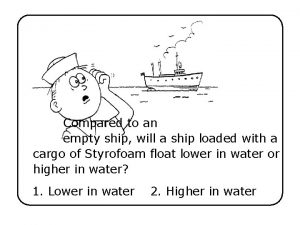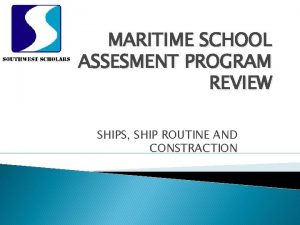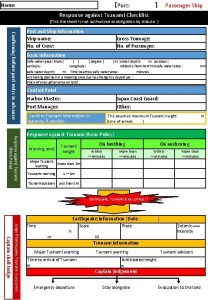Passenger Ship Port Name Response against Tsunami Checklist


- Slides: 2

】 Passenger Ship 【Port: Name: Response against Tsunami Checklist (This the sheet is not authorized as obligation by statute. ) Confirming before port entry in advance Port and Ship Information Ship name: No. of Crew: Gross Tonnage: No. of Passenger: Basic Information Safe water area: From ( Latitude: ) ( ) Degree ( Longitude: )m Water depth: m Location : Distance from berth to safe water area : nm safe water depth: m Time to arrive safe water area: minutes Anchoring position in a mooring area due to emergency departure : Place of evacuation area on land : Contact Point Harbor Master: Japan Coast Guard: Port Manager: Other: Confirm Tsunami information in advance, if possible. The assumed maximum Tsunami height: (time of arrival: ) m Response against Tsunami (Basic Policy) On berthing Warning level Tsunami height Major Tsunami warning More than 3 m Tsunami warning 1~ 3 m Within ~minutes More than ~minutes On anchoring Within ~minutes More than ~minutes Tsunami advisory Less than 1 m Earthquake, Tsunami is occurrred !! Earthquake Information (Date - Captain shall Judge if Earthquake, Tsunami is occurred Time m h Major Tsunami warning Time to arrival of Tsunami m Emergency departure Scale Place M ) Seismic Intensity Tsunami Information Tsunami warning Tsunami advisory Anticipated height m Captain Judgement Stay alongside Evacuation to the land

【Port: _______________________________ Basic Response List 】 Passenger Ship (Fill in the as far as practicable) Keep monitoring the latest information of Tsunami. (from TV, Radio or VHF) Confirm Tsunami occurrence indication from Port master, Harbor administrator, etc… Emergency departure *Continue to obtain the information of Tsunami (from TV, Radio or VHF) □ ① Standby crew and departure readiness (Engine and Thruster) ( minutes) ( □ ④ Check the suitability of the departure route (Proximity of hazards and other vessels in way ( of departure route) minutes) □ ② Announcement for the passengers □ ③ Check the Passenger boarding bridge (or movable bridge) □ ⑤ Consider shore mooring crew is necessary or not □ ⑥ Give notice to the shore (relevant departments or the operating company), after departure □ minutes) ( minutes) _____________________________ Staying alongside *Continue to obtain the information of Tsunami (from TV, Radio or VHF) □ ① Announcement for the passengers ( minutes) □ ② Tending mooring lines / Tightening brakes of mooring winches ( minutes) □ ③ Standby anchor ( minutes) □ ④ Standby engine and thruster if provided (To avoid damaging of lines, Surging) ( minutes) □ ⑤ Give notice to the shore (relevant departments etc) ( minutes) □ _____________________________ Evacuation to the land *Continue to obtain the information of Tsunami (from TV, Radio or VHF) □ ① Announcement for the passengers □ ② Readiness of crew and passengers ( minutes) □ ③ Check the safe area, the evacuation route, the required time to evacuate etc… □ ④ Instruct crew to evacuate to land □ ⑤ Carry out the required work on board till Evacuation to the land □ _____________________________ Attention in case of the drifting (Additional points) When Tsunami is occurred, the mooring may break, and the ship may drift from berth. And more there may be a risk that the terminal facilities such as a boarding bridge would collapse. Therefore crew must ensure well where the safe water area and the evacuation area on land are.



